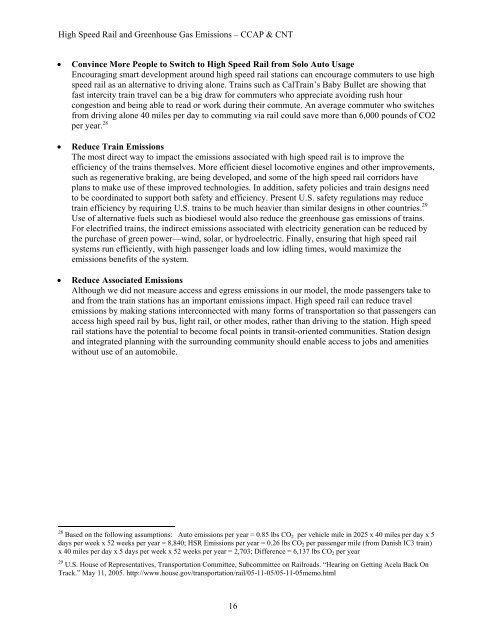High Speed Rail - Center for Neighborhood Technology
High Speed Rail - Center for Neighborhood Technology
High Speed Rail - Center for Neighborhood Technology
You also want an ePaper? Increase the reach of your titles
YUMPU automatically turns print PDFs into web optimized ePapers that Google loves.
<strong>High</strong> <strong>Speed</strong> <strong>Rail</strong> and Greenhouse Gas Emissions – CCAP & CNT<br />
• Convince More People to Switch to <strong>High</strong> <strong>Speed</strong> <strong>Rail</strong> from Solo Auto Usage<br />
Encouraging smart development around high speed rail stations can encourage commuters to use high<br />
speed rail as an alternative to driving alone. Trains such as CalTrain’s Baby Bullet are showing that<br />
fast intercity train travel can be a big draw <strong>for</strong> commuters who appreciate avoiding rush hour<br />
congestion and being able to read or work during their commute. An average commuter who switches<br />
from driving alone 40 miles per day to commuting via rail could save more than 6,000 pounds of CO2<br />
per year. 28<br />
• Reduce Train Emissions<br />
The most direct way to impact the emissions associated with high speed rail is to improve the<br />
efficiency of the trains themselves. More efficient diesel locomotive engines and other improvements,<br />
such as regenerative braking, are being developed, and some of the high speed rail corridors have<br />
plans to make use of these improved technologies. In addition, safety policies and train designs need<br />
to be coordinated to support both safety and efficiency. Present U.S. safety regulations may reduce<br />
train efficiency by requiring U.S. trains to be much heavier than similar designs in other countries. 29<br />
Use of alternative fuels such as biodiesel would also reduce the greenhouse gas emissions of trains.<br />
For electrified trains, the indirect emissions associated with electricity generation can be reduced by<br />
the purchase of green power—wind, solar, or hydroelectric. Finally, ensuring that high speed rail<br />
systems run efficiently, with high passenger loads and low idling times, would maximize the<br />
emissions benefits of the system.<br />
• Reduce Associated Emissions<br />
Although we did not measure access and egress emissions in our model, the mode passengers take to<br />
and from the train stations has an important emissions impact. <strong>High</strong> speed rail can reduce travel<br />
emissions by making stations interconnected with many <strong>for</strong>ms of transportation so that passengers can<br />
access high speed rail by bus, light rail, or other modes, rather than driving to the station. <strong>High</strong> speed<br />
rail stations have the potential to become focal points in transit-oriented communities. Station design<br />
and integrated planning with the surrounding community should enable access to jobs and amenities<br />
without use of an automobile.<br />
28 Based on the following assumptions: Auto emissions per year = 0.85 lbs CO2 per vehicle mile in 2025 x 40 miles per day x 5<br />
days per week x 52 weeks per year = 8,840; HSR Emissions per year = 0.26 lbs CO2 per passenger mile (from Danish IC3 train)<br />
x 40 miles per day x 5 days per week x 52 weeks per year = 2,703; Difference = 6,137 lbs CO 2 per year<br />
29 U.S. House of Representatives, Transportation Committee, Subcommittee on <strong>Rail</strong>roads. “Hearing on Getting Acela Back On<br />
Track.” May 11, 2005. http://www.house.gov/transportation/rail/05-11-05/05-11-05memo.html<br />
16



